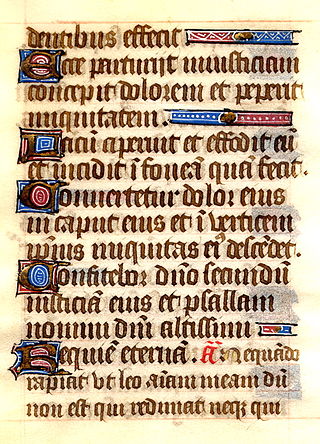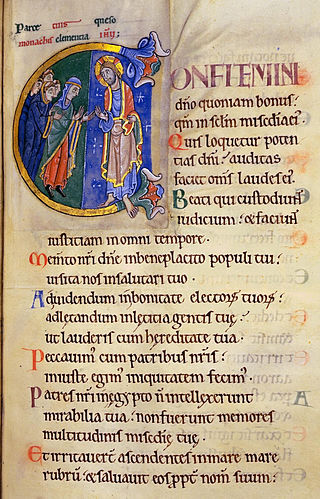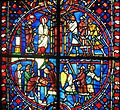
The Tridentine Mass, also known as the Traditional Latin Mass or the Traditional Rite, is the liturgy in the Roman Missal of the Catholic Church codified in 1570 and published thereafter with amendments up to 1962. Celebrated almost exclusively in Ecclesiastical Latin, it was the most widely used Eucharistic liturgy in the world from its issuance in 1570 until the introduction of the Mass of Paul VI.

Saint Lawrence or Laurence was one of the seven deacons of the city of Rome under Pope Sixtus II who were martyred in the persecution of the Christians that the Roman emperor Valerian ordered in 258.

Compline, also known as Complin, Night Prayer, or the Prayers at the End of the Day, is the final prayer liturgy of the day in the Christian tradition of canonical hours, which are prayed at fixed prayer times.

Intercession of the Saints is a Christian doctrine that maintains that saints can intercede for others. To intercede is to go or come between two parties, to plead before one of them on behalf of the other. In ecclesiastical usage both words are taken in the sense of the intervention primarily of Christ, and secondarily of the Blessed Virgin and the angels and saints, on behalf of men. The doctrine is held by the Catholic, Eastern Orthodox Churches, the Assyrian Church of the East, the Oriental Orthodox churches, and some Lutherans and Anglicans. The practice of asking saints for their intercession can be found in Christian writings from the 3rd century onwards.
Litany, in Christian worship and some forms of Jewish worship, is a form of prayer used in services and processions, and consisting of a number of petitions. The word comes through Latin litania from Ancient Greek λιτανεία (litaneía), which in turn comes from λιτή (litḗ), meaning "prayer, supplication".

The Confiteor is one of the prayers that can be said during the Penitential Act at the beginning of Mass of the Roman Rite in the Catholic Church. It is also said in the Lutheran Church at the beginning of the Divine Service, and by some Anglo-Catholic Anglicans before Mass.

A cephalophore is a saint who is generally depicted carrying their severed head. In Christian art, this was usually meant to signify that the subject in question had been martyred by beheading. Depicting the requisite halo in this circumstance offers a unique challenge for the artist: some put the halo where the head used to be, and others have the saint carrying the halo along with the head. Associated legends often tell of the saint standing and carrying their head after the beheading.

Nicasius, Quirinus, Scubiculus, and Pientia were venerated as martyrs and saints. Their feast day is 11 October. Their historicity is uncertain, and "no trustworthy historical reports of [them] exist."

Nicasius of Sicily is venerated as a martyr in the Catholic Church.

The accession of the King of France to the royal throne was legitimized by a ceremony performed with the Crown of Charlemagne at the Reims Cathedral. In late medieval and early modern times, the new king did not need to be anointed in order to be recognized as French monarch but ascended upon the previous monarch's death with the proclamation "Le Roi est mort, vive le Roi!"

Aignan or Agnan (358–453), seventh Bishop of Orléans, France, assisted Roman general Flavius Aetius in the defense of the city against Attila the Hun in 451. He is known as Saint Aignan.

Psalm 7 is the seventh psalm of the Book of Psalms, beginning in English in the King James Version: "O LORD my God, in thee do I put my trust: save me from all them that persecute me, and deliver me". In Latin, it is known as "Domine Deus meus in te speravi". Its authorship is traditionally assigned to King David. The message in the psalm is that the righteous may seem weak, but ultimately will prevail against the wicked.

Psalm 34 is the 34th psalm of the Book of Psalms, beginning in English in the King James Version: "I will bless the LORD at all times: his praise shall continually be in my mouth." The Book of Psalms is part of the third section of the Hebrew Bible, and a book of the Christian Old Testament. In the slightly different numbering system used in the Greek Septuagint and Latin Vulgate translations of the Bible, this psalm is Psalm 33. In Latin, it is known as "Benedicam Dominum in omni tempore".

Psalm 142 is the 142nd psalm of the Book of Psalms, beginning in English in the King James Version: "I cried unto the LORD with my voice." In the slightly different numbering system used in the Greek Septuagint version of the Bible, and the Latin Vulgate, this psalm is Psalm 141. In Latin, it is known as "Voce mea ad Dominum clamavi". It is attributed to David in the opening verses. It is labelled as a maschil or contemplation. The text is presented as a prayer uttered by David at the time he was hiding in the Cave of Adullam. Albert Barnes notes that "a prayer when he was in the cave" could mean it was a prayer which he composed while in the cave, or one which he composed at a later date, "putting into a poetic form the substance of the prayer which he breathed forth there." It is, consequently, used as a prayer in times of distress.

Psalm 122 is the 122nd psalm of the Book of Psalms, beginning in English in the King James Version: "I was glad" and in Latin entitled Laetatus sum. It is attributed to King David and one of the fifteen psalms described as A song of ascents. Its title, I was glad, is reflected in a number of choral introits by various composers.

Psalm 106 is the 106th psalm of the Book of Psalms, beginning in English in the King James Version: "Praise ye the LORD. O give thanks unto the LORD; for he is good". The Book of Psalms is part of the third section of the Hebrew Bible, and a book of the Christian Old Testament. In the slightly different numbering system used in the Greek Septuagint and Latin Vulgate translations of the Bible, this psalm is Psalm 105. In Latin, it is known by the incipit, "Confitemini Domino quoniam bonus". Alexander Kirkpatrick observes that the two historical psalms, Psalms 105 and 106, are closely related. Psalm 105 gives thanks for God's faithfulness to the covenant he made with Abraham; Psalm 106 is a psalm of penitence, reciting the history of Israel's faithlessness and disobedience. He also notes that this psalm and Psalm 107 "are closely connected together", arguing that "the division of the fourth and fifth books does not correspond to any difference of source or character, as is the case in the other books".

Psalm 118 is the 118th psalm of the Book of Psalms, beginning in the English of the King James Version: "O give thanks unto the LORD; for he is good: because his mercy endureth for ever." The Book of Psalms is part of the third section of the Hebrew Bible, and a book of the Christian Old Testament. In the slightly different numbering system used in the Greek Septuagint and Latin Vulgate translations of the Bible, this psalm is Psalm 117. In Latin, it is known as "Confitemini Domino". Its themes are thanksgiving to God and reliance on God rather than on human strength.

Nicasius Bernaerts, Monsù Nicasio or simply Nicasius was a Flemish painter of animals, hunting pieces and flowers who had an international career in Italy and Paris. He worked in his native Antwerp, Italy and France. In the final part of his career he worked for the French court and provided tapestry designs to the Gobelins Manufactory in Paris.

November 12 - Eastern Orthodox liturgical calendar - November 14
Saint Nicasius of Rouen, often known as the Apostle of the Vexin, was a 3rd-century saint and martyr in Gaul. He is sometimes considered the first Bishop of Rouen.



















